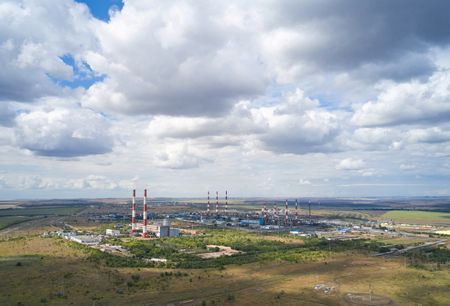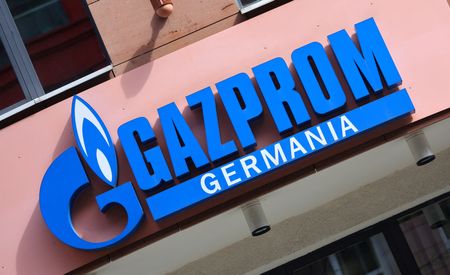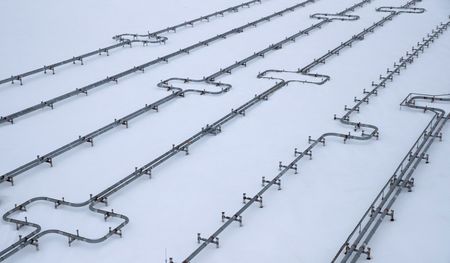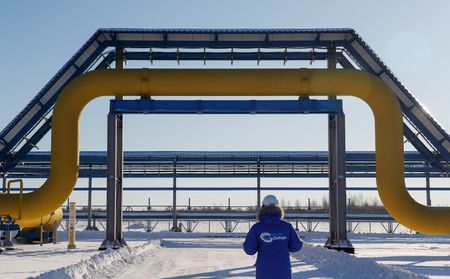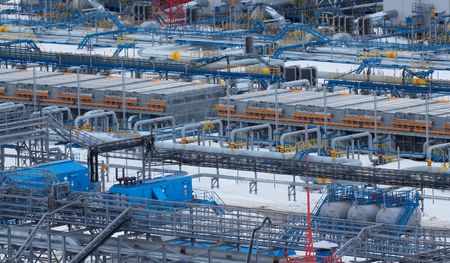By Vladimir Soldatkin
NOVY URENGOY, Russia (Reuters) – Meticulously crafted over decades as a major revenue stream for the Kremlin, Moscow’s gas trade with Europe is unlikely to recover from the ravages of military conflict.
After President Vladimir Putin’s “special military operation” in Ukraine began almost a year ago, a combination of Western sanctions and Russia’s decision to cut supplies to Europe drastically reduced the country’s energy exports.
The latest sanctions, including price caps, are likely to disrupt oil trade further but it is easier to find new markets for crude and refined products than for gas.
Russia’s gas trade with Europe has been based on thousands of miles of pipes beginning in Siberia and stretching to Germany and beyond. Until last year, they locked Western buyers into a long-term supply relationship.
“Of course, the loss of the European market is a very serious test for Russia in the gas aspect,” Yury Shafranik, Russian fuel and energy minister from 1993 to 1996, told Reuters.
A former senior manager at Gazprom was more direct.
“The work of hundreds of people, who for decades built the exporting system, now has been flushed down the toilet,” the former manager told Reuters on condition of anonymity for fear of reprisals.
Current employees, however, say it is business as usual.
“Nothing has changed for us. We had a pay rise twice last year,” a Gazprom’s official, who is not authorised to speak to press, told Reuters in Novy Urengoy. The Arctic city is often referred to as Russia’s “gas capital” because it was built to serve the biggest gas fields.
‘STATE WITHIN A STATE’
The state gas export giant Gazprom, which has offices there, was formed in the dying days of the Soviet Union in 1989 under the Ministry of Gas Industry, headed by Viktor Chernomyrdin.
“Chernomyrdin never allowed anyone to put his nose into Gazprom. It was a state within a state, and remains so to an extent,” Shafranik said.
Since the military operation began on Feb. 24 last year, less information has been available.
Like many Russian companies, Gazprom stopped disclosing details of its financial results.
According to Reuters’ estimates, based on export fees and export volumes data, Gazprom’s revenues from overseas sales were around $3.4 billion in January down from $6.3 billion in the same period last year.
The figures, combined with forecasts of exports and average gas prices, imply Gazprom’s exporting revenues will almost halve this year, widening the $25 billion budget deficit Russia posted in January.
Already, the company’s natural gas exports last year almost halved to reach a post-Soviet low and the downward trend has continued this year.
European Commission President Ursula von der Leyen estimated Russia cut 80% of gas supplies to the EU in the eight months after the conflict began in Ukraine.
As a result, Russia supplied only around 7.5% of western Europe’s gas needs by the end of last year, compared with around 40% in 2021.
Before the conflict, Russia had been confident of selling more to Europe, not less.
Elena Burmistrova, the head of Gazprom’s exporting unit, told an industry event in Vienna in 2019 the company’s record-high exports outside Soviet Union of more than 200 billion cubic metres (bcm) achieved in 2018 were the “new reality”.
Last year, the total was just above 100 bcm.
Russia’s transporting capacities were undermined last year after mysterious blasts in the Baltic Sea at the Nord Stream pipelines from Russia to Germany. Russia and the West blamed each other for the blasts.
Pulitzer Prize-winning U.S. reporter Seymour Hersh in a blog said the United States was responsible, which the United States said was ‘utterly false’.
Washington has long criticised Germany’s policy of reliance on Russian energy, which until last year, Berlin had said was a means to improve relations.
THE DEAL OF THE 20TH-CENTURY
For his part, Putin had been seeking to diversify Russia’s gas markets long before last year, but the policy has gathered momentum.
In October, he mooted an idea of a gas hub in Turkey to divert the Russian gas flows from the Baltic Sea and North-West Europe.
Russia is also seeking to boost its pipeline gas sales to China, the world’s largest energy consumer and top buyer of crude oil, liquefied natural gas (LNG) and coal.
Supplies began via the Power of Siberia Pipeline in late 2019 and Russia aims to raise the annual exports to around 38 bcm from 2025.
Moscow also has an agreement with Beijing for another 10 bcm per year from a yet-to-be built pipeline from the Pacific island of Sakhalin, while Russia is also developing plans for Power of Siberia 2 from Western Siberia, which in theory could supply an additional 50 bcm per year to China.
Whether that relationship can be as lucrative as the decades of supplying gas to Europe remains to be seen.
Gazprom’s most important assets are located in West Siberia and in the wider Arctic Yamal region, where the 100,000-strong city of Novy Urengoy, which celebrates its 50th-anniversary in 2025, houses seasonal workers in utilitarian, high-rise blocks.
One of the fields in the tundra area, around 3,500 kilometres (2,175 miles) northeast of Moscow, where they work is Urengoy.
Following the discovery of the field, which is among the world’s largest in 1966, the Soviet Politburo began talks with Western Germany on exchanging gas for pipes, as Russia then lacked production technology.
The resulting agreement, dubbed the “contract of the century” was finalised in 1970 after the then Soviet Foreign Minister Andrei Gromyko, nicknamed “Mr Nyet” in the West for his uncompromising approach, said “da” to the gas-for-pipes deal, which involved supplies of heavy equipment for Moscow as well as gas for Europe.
The 20-year supply deal is worth about $30 billion in current gas prices.
It meant that for decades, Europe and, especially Germany, benefited from relatively cheap, long-term contracts, and relied on Russian natural gas, or methane, for heating households and as a feedstock for the petrochemical industry.
COMPLEX NEGOTIATIONS AHEAD
The negotiations with China on new gas sales are expected to be complex, not least because China is not expected to need additional gas until after 2030, industry analysts said.
Russia also faces far more competition than in the past from renewable energy as the world seeks to limit the impact of climate change, as well as rival pipeline gas supplies to China, including from Turkmenistan.
LNG, which can be shipped anywhere in the world, has further reduced the need for pipeline gas.
Gazprom and China have kept their agreed gas price a secret. Ron Smith, analyst at Moscow-based BCS brokerage, expected the price for 2022 to average $270 per 1,000 cubic metres, much lower than prices in Europe.
It is also below Gazprom’s export price of $700 per 1,000 cubic metres, expected by Russian Economy Ministry this year.
Last year, Russia’s energy finances, which are not broken down publicly into oil and gas, were supported by the market impact of fears of shortage.
In Europe, gas prices hit record levels and international oil prices shortly after the special military operation began spiked close to their all-time high.
Since then, prices for gas and oil have eased and Western price caps introduced in December and early this year are designed to erode Russia’s revenues further.
The Kremlin meanwhile has set Gazprom the mammoth task of building 24,000 kilometres of new pipelines to provide gas for 538,000 households and apartments in Russia from 2021 to 2025.
Domestic gas prices are regulated by the government and there have been discussions about liberalising the gas market, a sensitive issue for Russian households.
Back in Novy Urengoy, where temperatures fall to as low as almost minus 50 Celsius (minus 58 Fahrenheit), Achimgaz, a joint venture between Gazprom and Germany’s Wintershall Dea, also has offices and the flag of Austrian energy company OMV flaps outside an administrative building.
Asked about its presence there, an OMV spokesperson said only the building housed offices of the operator of the Yuzhno-Russkoye field, where the company has a stake.
OMV in March scrapped plans to take a stake in a Gazprom gas field project, while Wintershall Dea, in which BASF holds just under 73% percent, said last month it was pulling outof Russia.
The Gazprom official who spoke on condition of anonymity said the company will regret that.
“We will just have to use more gas for our domestic households instead of exporting it to Europe. China also needs gas,” the official said.
(Reporting by Vladimir Soldatkin; additional reporting by Alexandra Schwarz-Goerlich in Vienna; editing by Barbara Lewis)

